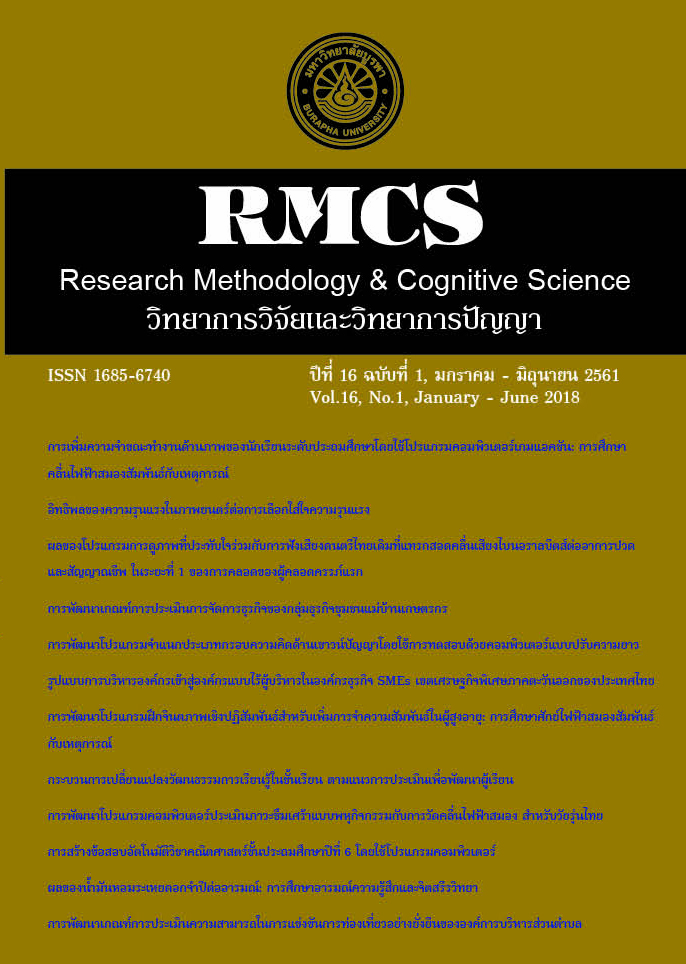The Development of Intelligence Mindset Classification Program Using Variable-Length Computerized Testing
Main Article Content
Abstract
Intelligence mindset is a belief about development of their own intelligence. This research aimed to develop intelligence mindset scale for undergraduate student, to construct an item bank for an intelligence mindset scale, to develop intelligence mindset classification program using variable-length computerized testing, and to compare intelligence mindset among undergraduate students. The study process consists of four phases: 1) construct quality items for an intelligence mindset scale, 2) construct a quality item bank for an intelligence mindset scale, 3) develop intelligence mindset classification program using variable-length computerized testing, and 4) compare intelligence mindset among undergraduate student in Health Sciences, Social Sciences and Humanity, and Sciences and Technology by using Chi-Square Test. The research results indicated that
1) There are 99 quality items for an intelligence mindset scale.
2) The items were used to construct a quality item bank for an intelligence mindset scale that was divided into nine sub-item banks including of Verbal-Linguistic (6 items), Logical-Mathematical (7 items), Visual-Spatial (9 items), Musical (11 items), Bodily-Kinaesthetic (8 items), Interpersonal (15 items), Intrapersonal (15 items), Naturalistic (15 items), and Existential (13 items).
3) Intelligence mindset classification program using variable-length computerized testing was suitable for use in high level.
4) The intelligence mindset among undergraduate students in Logical-Mathematical component, Bodily-Kinaesthetic component, and Naturalistic component were found the significant difference at the .05 level.
Article Details
References
ปัทมา อนันต์, เสรี ชัดแช้ม, และสมพร สุทัศนีย์. (2551). ความแตกต่างทางเพศในปัญญาเชิงปฏิบัติระหว่างนักเรียนช่วงชั้นที่ 3 กับช่วงชั้นที่ 4. วารสารวิจัยและวัดผลการศึกษา มหาวิทยาลัยบูรพา, 6(1), 109-124.
วินิทรา นวลละออง, ธันยา นวลละออง, นงลักษณ์ ปรีชาดิเรก, อริญา อุ่นบัวทอง, วรเวช มูลนิสาร, จิณณะ แดงสุวรรณ, และเอกลักษณ์ สหายา. (2557). ความพึงพอใจของนักเรียน
และครูชั้นประถมศึกษาปีที่ 1 ต่อการเรียนรู้ซึ่งมีพื้นฐานจากพหุปัญญาผ่านเทคโนโลยี augmented reality ในอุปกรณ์แท็บเล็ต. วารสารสมาคมจิตแพทย์แห่งประเทศไทย,
59(3), 245-256
Ariffina S. R., Bakar I. K. A., Harun M. S. C., & Isa A. (2010). Verification of multiple intelligences construct validity in an online instrument. Procedia Social
and Behavioral Sciences, 9,1894-1899.
Blackwell, L. A., Trzesniewski, K. H., & Dweck, C. S. (2007). Theories of intelligence and achievement across the junior high school transition: A longitudinal
study and an intervention. Child Development, 78(1), 246-263.
Cohen, R. J., & Swerdlik, M. E. (2010). Psychological testing and assessment: an introduction to tests and assessments(7 th ed.). New York: McGraw-Hill Higher Education.
Davis, K., Christodoulou, J., Seider, S., Gardner, H. (2011). Cambridge handbook of intelligence. New York: Cambridge University Press.
De Ayala, R. J. (2009). The theory and practice of item response theory. New York: The Guildford Press.
Dehaene S., Spelke E., Pinel P., Stanescu R., & Tsivkin S. (1999). Sources of mathematical thinking: behavioral and brain-imaging evidence. Science,
284(5416), 970-974.
Dweck, C.S. (2006). Mindset: The new psychology of success. New York: Random House.
Dweck, C. S. (2015). Test your mindset. Retrieved November 3, 2015, from http://www.mindsetonline.com/testyourmindset/step1.php
Embretson, S. E., & Reise, S. P. (2000). Item response theory for psychologists. Mahwah, New Jersey: Lawrence Erlbaum.
Gardner, H., & Moran, S. (2006). The science in multiple intelligences: A response to Lynn Waterhouse. Educational Psychologist, 41(4), 227-232.
Hadipoor, M., Jomehri, F., & Ahadi, H. (2015). The effect of training program based on theory of mindset about Intelligence on learning behaviors of preschoolers (4-6 Years): A three-stage experiment. International Journal of Review in Life Sciences, 5(8), 1047-1055.
Lau, C. A., & Wang, T. (1998). Comparing and combining dichotomous and polytomous items with SPRT procedure in computerized classification testing. Paper presented at the annual meeting of the American Educational Research Association, San Diego.
Lunenburg, F. C., & Lunenburg, M. R. (2014). Applying multiple intelligences in the classroom: A fresh look at teaching writing. International Journal of Scholarly Academic Intellectual Diversity, 16(1), 1-14.
Paunesku, D., Walton, G. M., Romero, C., Smith, E. N., Yeager, D. S., & Dweck, C. S. (2015). Mind-set interventions are a scalable treatment for academic
underachievement. Psychological Science, 1-10. doi:10.1177/0956797615571017.
Pica, P., Lemer, C., Izard, V., & Dehaene, S. (2004). Exact and approximate arithmetic in an Amazonian indigene group.Science, 306(5695), 499-503.
Smits, N., Cuijpers, P., & Straten, A. V. (2011). Applying computerized adaptive testing to the CESD scale: A simulation study. Psychiatry Research, 188(1),
147-155.
Smits, N. & Finkelman, M. D. (2013). A comparison of computerized classification testing and computerized adaptive testing in clinical psychology. Journal of Computerized Adaptive Testing, 1(2), 19-37.
Sreenidhi, S. K. & Tay, C. H. (2017). Multiple intelligence assessment-based on Howard Gardner’s research. International Journal of Scientific and Research
Publications (IJSRP), 7(4), 203-213.
Thompson, N. A. (2006). Variable-length computerized classification testing with Item Response Theory. CLEAR Exam Review, XVII(2), 13-18.
Thompson, N. A. (2007). A practitioner’s guide for variable-length computerized classification testing. Practical Assessment Research & Evaluation, 12(1), 1-13. Available online: http://pareonline.net/getvn.asp?v=12&n=1
Valentiner, D. P., Jencius, S., Jarek, E., Gier-Lonsway, S. L., & McGrath, P. B. (2013). Pre-treatment shyness mindset predicts less reduction of social anxiety
during exposure therapy. Journal of Anxiety Disorders, 27(3), 267-271.
Vogels, A. G., Jacobusse, G. W., & Reijneveld, S. A. (2011). An accurate and efficient identification of children with psychosocial problems by means
of computerized adaptive testing. BMC Medical Research Methodology, 11(1), 1-9.
Yearger, D. S., Trzesniewski, K. H., & Dweck, C. S. (2013). An implicit theories of personality intervention reduces adolescent aggression in response to victimization and exclusion. Child Development, 84(3), 970-988.

